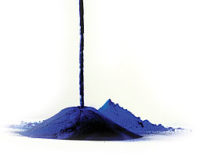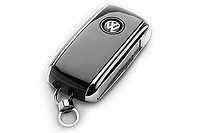Ultramarine Blue

Can anyone claim that a "new" blue color space has been "discovered" when talking about a pigment that has been in use for almost 200 years? Are paint makers so acquainted with the Ultramarine Blue pigment that it no longer holds anything of real interest to them?
This article aims to change the way the coatings industry sees Ultramarine Blues, because Nubiola has developed revolutionary technologies to make this "old" discovery a high-performance pigment for a wide range of 21st century coatings applications.

History of Ultramarine Blue Pigments
Ultramarine Blue (PB 29) is an inorganic blue pigment that was mainly used in laundry applications until well into the 1980s - blended in powder detergents, soap bars and the like, to enhance the whiteness of white-cotton fabrics when washed - due to its ability to adhere to fibers and absorb yellow wavelengths. Other applications were also popular by then: the tinting of white paper and white mineral fillers, and the blue coloration of artists' colors, among others.In the coatings industry, Ultramarine Blue has traditionally been used to tint white paints in order to provide a blue undertone highly appreciated by paint makers. The benefits are clear: absorbance of yellow wavelengths, low tinting strength, the desired undertone and sufficient dispersibility. But Ultramarine Blue has hardly been used to make truly blue paints so far. Why is this?
Phthalocyanine Blue pigments have been known since the late 1930s, and became the industry standard to manufacture blue paints due to its good performance and availability. When Ultramarine Blue entered the industrial market with more strength in the late 1980s in the plastics industry, there were already plenty of barriers to the use of Ultramarine Blue pigments in coatings.
On one hand there were strong technical barriers. The perception of industry technicians was that the pigment's performance was not adequate for some of the technical requirements of paint manufacturing: lack of tinting strength, low light and weather resistance, limited dispersibility, low opacity, and a sulphur odor. On the other hand, Phthalocyanine Blue was already a well-established and known pigment in this industry. Formulators were used to it and had adapted all formulations to that standard pigment. Therefore, at that time, there were no good reasons to consider Ultramarine Blue as a potential pigment to add to the paint producers' blue pigments portfolio. This has continued for the most part to the present time.

A 21st Century Opportunity
Fierce competition in the global coatings marketplace arose in the mid 1990s. The number of large competitors increased with mergers and acquisitions that have brought large corporations together in an attempt to gain market share. Moreover, globalization has made the target market of any company, little or big, the world. Unfortunately, the demand has progressively become more and more stagnant in the largest but also most mature markets of Western Europe and North America. However, there are fast-growing markets for coatings in China and India, but the sophistication of these markets is yet to arrive. Therefore, the only way for any paint producer to get away from this dangerous circle is to become differentiated from its competitors in order to provide more added value to the market. The introduction of Ultramarine Blues in the color portfolio of any paint maker is a good start to become different. The reason is that Ultramarine Blue is located in a blue color space that no other pigment or blend of pigments can occupy (Figure 1). And, as said before, this pigment has hardly been used to make blue paints so far. Being the first is many times the key to success.The reddish undertone of Ultramarine Blue makes things painted in blue look warmer, brighter and deeper, both in full (intense) and reduced (pastel) shades. This is in comparison to the greenish undertone that Phthalocyanine Blue provides, which shows a cooler, duller blue color, even when they are blended with organic violet pigments.
In the last three years, Nubiola has conducted more than 80 face-to-face interviews with paint manufacturers all over the world, and 100% of them agreed with this statement when draw-downs comparing Ultramarine Blue and other blue pigments were shown.

NUBICOAT - the New Ultramarine Blue Range
With respect to the technical limitations of the "old" Ultramarine Blues to be used in this industry, Nubiola dedicated four years of R&D to develop solutions for the weaknesses that arose when the market search mentioned above was carried out. The outcome of all that work became the new NUBICOAT range, a new Ultramarine Blue range specifically designed to overcome the most important existing technical barriers.The new NUBICOAT range consists of two products in powder form:
NUBICOAT HTS is produced with new manufacturing technology that provides 40% more color strength and enhanced dispersibility/gloss/transparency compared to conventional Ultramarine Blues used in coatings. Moreover, these allow customers either to make paints with higher hiding power at the same color luminosity than in the past, or to make paints with the same hiding power as in the past with a stronger blue color. NUBICOAT HTS is highly indicated for indoor applications and for outdoor applications that work with highly crosslinked and light-resistant binders/systems.
NUBICOAT HWR is manufactured with new silica encapsulation technology developed by Nubiola to protect the pigment particle from acids. This encapsulation makes the pigment resistant to industrial/acid outdoor environments that can spoil non-encapsulated Ultramarine Blues if poorly crosslinked binders are used. It also provides 60% more tinting strength than existing conventional acid-resistant Ultramarine Blues. Enhanced dispersibility, high abrasion resistance and low oil absorption are other attributes of this product. NUBICOAT HWR is highly indicated for any outdoor application, any application that requires acid resistance and any outdoor/indoor binder that can release acid components when ageing. After dozens of trials using QUV equipment and more than two years' outdoor exposure in a hot, industrial atmosphere with high marine humidity in Barcelona (Spain), the weather resistance tests show similar results to those achieved by Cobalt Blues and high-quality Phthalocyanine Blues.
For those customers that require liquid versions of these products instead, such as pigment dispersions, Nubiola offers the NUBICOAT D series that is APE/VOC free, 60% pigment concentration preparations for waterborne paints.
All these new attributes of the NUBICOAT range are added on top of the traditional strengths of the Ultramarine Blues for coatings: environmentally friendly profile, high transparency (very much required in many applications), lack of metamerism, high alkali and organic solvent-resistance, and high wettability.
Table 1 shows more detailed information about the recommended indications of use of both products and the main segments where they can be applied.
Summary
NUBICOAT, the new Ultramarine Blue range from Nubiola, means a new "color" opportunity in the blue space. An old pigment has been rediscovered, redesigned and adapted to the requirements of the coatings of the 21st century. It is a clear opportunity for product differentiation in all the color portfolios of paint producers. It is time to change people's minds. It is time to be unique when painting the world blue!For more information, visit www.nubiola.com.
Looking for a reprint of this article?
From high-res PDFs to custom plaques, order your copy today!





